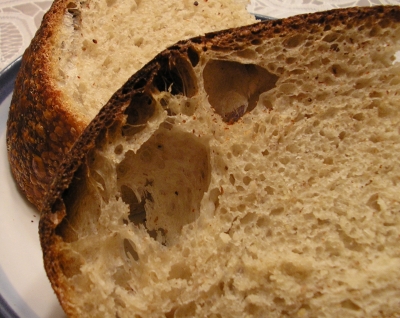
Then there's also the possibility of a starter made with rye flour (or even something more unusual), one with grape skins or beer yeast added, or sourdough cultures from different parts of the world. (San Francisco sourdough is pretty different from French or German.) From as best I can tell, Mulder has a much milder flavour than Scully. Apparently Europeans tend not to like a strong acidic, sourdough flavour, so there are recipe differences to account for, but I'd say the smell of the starters supports that statement. Breads I made with Scully are more easily recognisable as sourdough, though both make good breads and are equally powerful leaveners.
French country breads are one of the few recipes I've found that actually call for a whole wheat starter, so I tried making them fairly frequently when I first started using sourdough. I made, I think, three attempts at the recipe in The Bread Book, which seemed like it had adequate instructions, and loads of pictures along the way, but I still kept ending up with dense, salty, flat loaves of bread. I found the recipe in Crust & Crumb much less confusing, and even figured out what I was doing wrong before. My biggest problem was that I wasn't kneading enough. I was worried about overworking the bread, since I'd read a lot about that recently. But the reason I'd read about it was because more people are using electric mixers instead of kneading these days. I was relieved to learn it's impossible to overwork bread kneading by hand -- your arms would fall off first. Then there's the complaint I made earlier about The Bread Book and its insistence on using hand-ground coarse sea salt, causing measuring problems for anyone else. I also found their instructions strangely confusing. I mean, the bread has only three ingredients. Even if it takes two days and two nights to make, it can't be *that* hard.

I love the blistered crust on this. It's very thin and crisp on the top, though it gives quite a bit on the sides near the bottom. The crumb is very light and airy like an enriched bread, but still has that chewy, buttery texture of a lean bread. I'm also pleased with my big air bubbles and irregular crumb! I think baking it on my baking stone would have improved the crust, but I wanted to bake both loaves at once. It's so soft it's impossible to cut slices thinner than an inch, but it's a nice bread for soups and eating plain, so I don't think it matters that I'll never get a sandwich out of it. I also need to work on cutting better slashes in the dough.
French Country Sourdough
paraphrased from Crust & Crumb by Peter Reinhart
1 cup proofed whole wheat sourdough starter
1 cup unbleached bread flour
6 tablespoons water
Stir these ingredients together to form a ball of dough. Knead into a smooth ball, place in a clean bowl, cover with plastic wrap, and let rise at room temperature for four hours, then refrigerate overnight.
Cut the dough into six pieces and mix with:
5 1/4 cups unbleached bread flour
2 cups cool water
2 1/2 teaspoons salt
Mix and knead until smooth (the dough should pass the windowpane test).
Put the dough in a clean bowl, cover with plastic wrap and let rise at room temperature for three hours, or until it has just begun to rise.
Divide the dough into two pieces (to make two loaves) and form boules. Place them on cooking sheets lined with baking parchment, sprinkled with semolina flour. Spray dough with oil and cover with plastic wrap. Let rise at room temperature for four hours, then refrigerate overnight.
(The actual recipe called for letting the dough rise in bannetons or baskets, but I can't have nice things, so I just let mine rise without that. A basket would have given my loaves a rounder shape.)
Remove the dough from the refrigerator one hour prior to baking and preheat the oven to 475*F with a steam pan on the bottom rack, and a baking stone on top (if you plan to use one). (I had a baking stone on the floor of the oven, a steam pan on the bottom rack, and baked both loaves of bread on one pan on the top rack, which is probably why they got very dark on top, but stayed soft on the bottom.)

Once the oven is hot, either slide the baking parchment onto the baking stone, or put the pan into the oven. Pour a cup of boiling water into the steam pan, mist the oven walls with water and close the oven door. Mist again after about a minute, then again in another minute, then lower the temperature to 450*F.
Bake for 30 minutes (rotating loaves halfway through if necessary), or until the crust is dark reddish-brown. Let cool on the baking pan for about five minutes, then transfer to a wire rack and let cool one hour before slicing and eating.